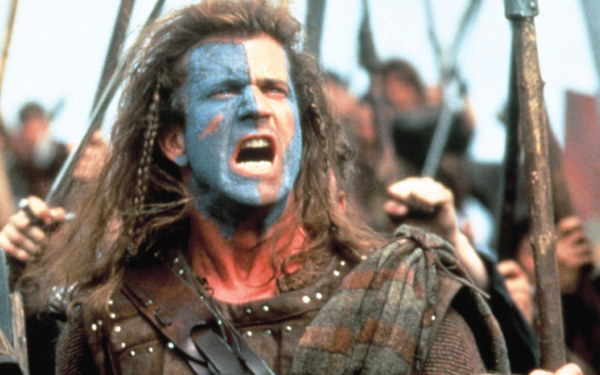By Ron Suppa.
Forgive the cliché, but a picture is worth a thousand words. Unlike stage plays, movies don’t have to rely on words to tell the story. In fact, the first movies were silent. If today’s action blockbusters are any indication, we may be heading back that way. And for good reason – communication in film is primarily a non-intellectual, emotional process. The ideas expressed in film are best expressed through dramatization, not by stating them out loud. It’s an intuitive process – one that appeals directly to the heart.
But ask an actor what he or she reads first in a script and they’ll tell you the dialogue. Ask a producer or agent or studio exec and you’ll get the same answer – they read the first few pages and after that their eyes tend to skip down the page to the dialogue exchanges. That’s because the first job of a marketable screenplay is to attract talent (in the world of movies, “talent” means actors) and the clearest window into the heart, mind, and emotions of the characters the talent is asked to play is the words they are asked to say.
Screen dialogue is fundamentally different from words spoken in stage plays, or certainly in everyday life. Stage actors have little besides words to tell the story and to give nuance and depth to their characters, so long speeches are sometimes necessary. In film, everything from a wayward glance to a series of quick cuts in a montage can fill those needs. And though movie-speak may sound like the way people speak in life, that’s only a creative construct – put five minutes of movie dialogue up against what real people say in a five-minute conversation around a dinner table and you would see the difference.

Wallace Shawn as Wally Shawn in My Dinner with Andre
Characters in a film converse to communicate plot and character – not to pass the time. They cut to the heart of conversation and never waste words. (Six sentences on screen can seem a lengthy speech.) Heroes, in particular, like to act, not talk. When characters do speak, they have a tight agenda: movie-speak is not repetitious, doesn’t go on and on, doesn’t interrupt (often), doesn’t beat around the bush (another cliché), is not full of awkward pauses, non-sequiturs, mindless chit-chat, or even polite formalities like saying goodbye at the end of a phone call. Because movie-speak isn’t real dialogue at all – it only mimics real dialogue. The goal is dialogue that feels real. Movie-speak is direct, terse, purposeful, informal, and often delivers just the perfect turn of a phrase we might say if we could consider our words, write and rewrite them and polish them to a shine.
Words in film serve the same story function as the scene in which they are spoken:
- to advance the plot
- supply information
- reveal character, and
- foster dramatic conflict.
Express your story in cinematic terms. Think action. Don’t have a speech tell the story, dramatize it. When your film plays in other countries, you don’t want it to be a reading assignment. The whole world loves brevity. It saves time and is easier on the eyes. (Yes, eyes. Audiences read lips when they watch a movie. Ever see a film where the soundtrack is a millisecond out of sync with the actors speaking?)
As an exercise, cut out all dialogue and see what you have left. Do the visuals tell the story? Is it at least an interesting visual experience? If not, take the characters out of cars and apartments and off phones or analyst couches and have them talk while jogging across Central Park or shooting hoops in a YMCA. Or juxtapose necessary exposition with bizarre locations or circumstances, such as a cop questioning a doctor about an affair with a dead victim as the doctor autopsies the corpse in a pathology lab.

John Travolta as Vincent Vega and Samuel L. Jackson as Jules Winnfield in Pulp Fiction
With special effects and CGI driving many plots, more is asked of less dialogue than ever before. The few precious scenes in which characters actually speak with each other in between the quick cuts and rapid pace of action sequences is often all we have to discover their character and complexity. Yet writers cannot give in to the temptation to use those moments to expound on the theme or wax poetic. Film is a visual medium. Long exchanges of dialogue or lengthy speeches can bring the visuals to a grinding halt. And actors will resist saying anything at all (“Here, take my sword.”) if they can simply perform the action or give a reaction (a nod of the head instead of having to say “yes”).
Of course, there are wonderful examples of long speeches lighting up a movie: Robert Shaw in Jaws revealing his scars along with the personal source of his hatred for sharks; Jack Nicholson exploding on the witness stand in A Few Good Men and telling Tom Cruise that “you can’t handle the truth;” a rain-soaked Peter Finch, in Network, informing the world that he’s “mad as hell and not going to take it any more;” Mel Gibson in Braveheart rallying his troops for a battle that looks certain to be a suicide mission; Al Pacino giving his final statement to the jury in “ . . . And Justice for All”, pointing to his own client and saying “the son of a bitch is guilty!” But these classic movie moments are memorable precisely because such speeches are rare and, even more rarely, done well. If you feel you must do a long speech, try and make it a turning point in your movie and pace it out through interweaving reaction shots or cuts to parallel action.

Peter Finch as Howard Beale in Network
One important caveat: while dialogue is used to indirectly expose a character’s feelings, needs, flaws and motivations, never have the character state any of those things directly because we won’t believe him. Real character revelation is almost squeezed out reluctantly through conflict. In Thelma and Louise we learn about Louise’s terrible experiences in Texas through the eyes of the detective on her tail, Thelma figures it out on her own somewhere toward the end, but Louise never mentions a word about it. In The Verdict, Galvin’s friend and ally tells his girlfriend how things went down long ago and how Galvin got royally screwed, but Galvin’s not in the bar at the time. To be there or mention it himself would not only be self-serving, but would make him into a whiner.
And though Paul Newman can get away with doing it in the speech-friendly context of a final argument to a jury in The Verdict, avoid having your characters be mouthpieces for your theme, or have them tell us what we’re seeing, or worse, what we’ve already seen!
 In the second part of this article, I’ll set forth some basic strategies for creating good screen dialogue. Read it Here!
In the second part of this article, I’ll set forth some basic strategies for creating good screen dialogue. Read it Here!
 If you enjoyed this article, why not check Ron’s DVD, What To Do After It’s Written, available to purchase in our store?
If you enjoyed this article, why not check Ron’s DVD, What To Do After It’s Written, available to purchase in our store?

